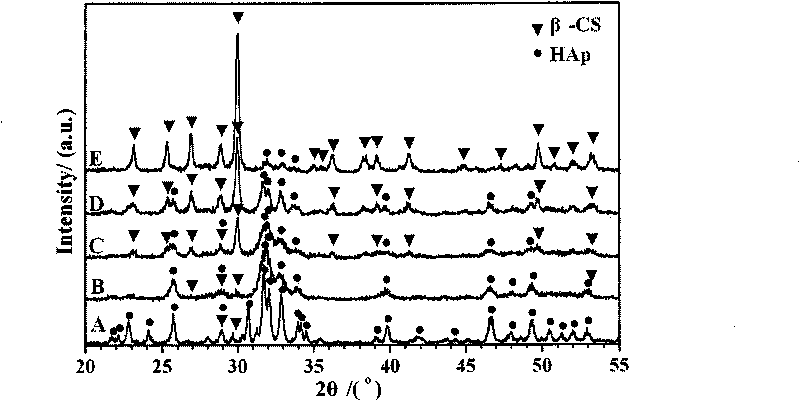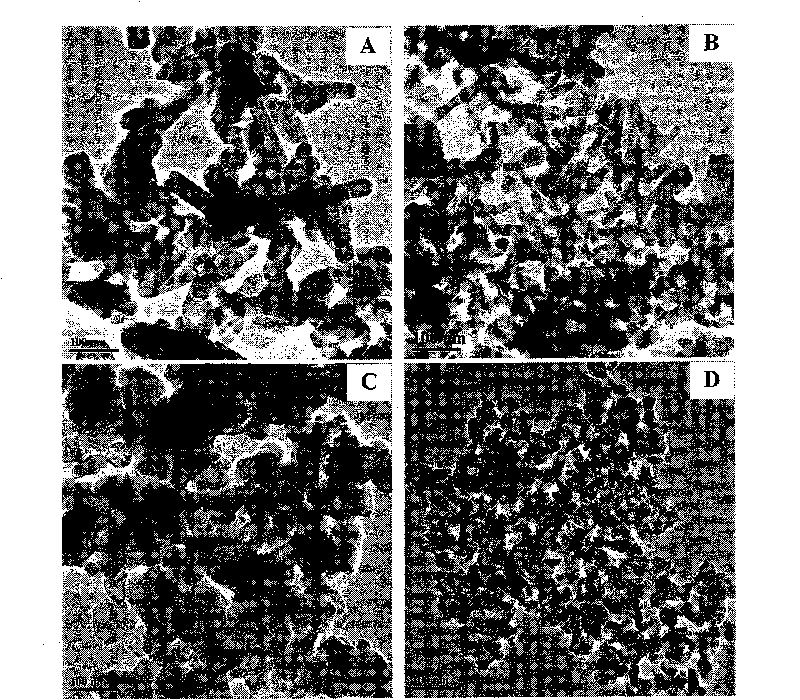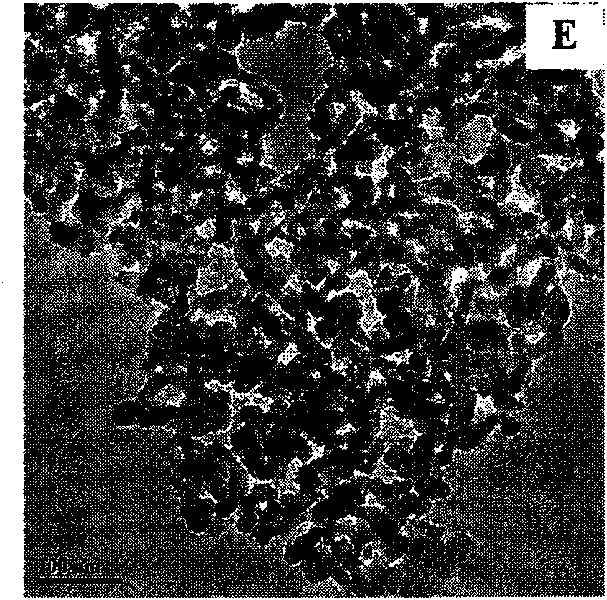Calcium silicate/hydroxylapatite composite biological ceramic material and preparation method and application thereof
A composite bioceramic and hydroxyapatite technology, applied in medical science, prosthesis, etc., can solve the problems of high purity requirements, long time-consuming, poor degradability of biological materials, etc., and achieve the effect of controllable mechanical strength
- Summary
- Abstract
- Description
- Claims
- Application Information
AI Technical Summary
Problems solved by technology
Method used
Image
Examples
Embodiment 1
[0046] The powder raw material preparation method used is as described above. Take 58.80 grams of Ca(NO 3 ) 2 Dissolved in 500mL deionized water, and adjusted to pH=11 with 1:1 ammonia water, 19.73 grams of (NH 4 ) 2 HPO 4 Dissolve in 500mL deionized water to get (NH 4 ) 2 HPO 4 aqueous solution. The above (NH4 ) 2 HPO 4 The aqueous solution was added dropwise to the Ca(NO 3 ) 2 In the solution, the pH value of the reaction system was maintained at 11 with a 1:1 ammonia solution during the feeding process, and the stirring was continued for 24 hours after the addition, and the hydroxyapatite nano-powder was obtained by filtration, and the hydroxyapatite nano-powder was dispersed in 500 mL to remove deionized water, and dissolved 50.89 g Ca(NO 3 ) 2 , to obtain a white suspension dispersed with hydroxyapatite nanopowder; 500mL of pH 11.0 and 61.25g of Na 2 SiO 3 The aqueous solution was added dropwise to the above suspension, and the pH of the reaction system was...
Embodiment 2
[0052] The powder raw material preparation method used is as described above. Take 211.68 grams of Ca(NO 3 ) 2 Dissolved in 1800mL deionized water, and adjusted to pH=11 with 1:1 ammonia water, 71.01g of (NH 4 ) 2 HPO 4 Dissolve in 1000mL deionized water to get (NH 4 ) 2 HPO 4 aqueous solution. The above (NH 4 ) 2 HPO 4 The aqueous solution was added dropwise to the Ca(NO 3 ) 2 In the solution, the pH value of the reaction system was maintained at 11 with a 1:1 ammonia solution during the feeding process, and the stirring was continued for 24 hours after the addition, and the hydroxyapatite nano-powder was obtained by filtration, and the hydroxyapatite nano-powder was dispersed in 200 mL to remove ionized water, and dissolved 20.36 g Ca(NO 3 ) 2 , to obtain a white suspension dispersed with hydroxyapatite nanopowder; 200mL of pH 11.0 and 24.50 Na 2 SiO 3 The aqueous solution was added dropwise to the above suspension, and the pH of the reaction system was kept ...
Embodiment 3
[0058] The powder raw material preparation method used is as described above. Take 23.52 grams of Ca(NO 3 ) 2 Dissolved in 200mL of deionized water, and adjusted to pH=11 with 1:1 ammonia water, 7.89g of (NH 4 ) 2 HPO 4 Dissolve in 120mL deionized water to get (NH 4 ) 2 HPO 4 aqueous solution. The above (NH 4 ) 2 HPO 4 The aqueous solution was added dropwise to the Ca(NO 3 ) 2 In the solution, the pH value of the reaction system was maintained at 11 with a 1:1 ammonia solution during the feeding process, and the stirring was continued for 24 hours after the addition, and the hydroxyapatite nano-powder was obtained by filtration, and the hydroxyapatite nano-powder was dispersed in 1800mL to remove ionized water, and dissolved 183.24 g Ca(NO 3 ) 2 , to obtain a white suspension dispersed with hydroxyapatite nanopowder; 800mL of pH 11.0 and dissolved with 220.50g of Na 2 SiO 3 The aqueous solution was added dropwise to the above suspension, and the pH of the react...
PUM
| Property | Measurement | Unit |
|---|---|---|
| Concentration | aaaaa | aaaaa |
| Elastic modulus | aaaaa | aaaaa |
| Elastic modulus | aaaaa | aaaaa |
Abstract
Description
Claims
Application Information
 Login to View More
Login to View More - R&D
- Intellectual Property
- Life Sciences
- Materials
- Tech Scout
- Unparalleled Data Quality
- Higher Quality Content
- 60% Fewer Hallucinations
Browse by: Latest US Patents, China's latest patents, Technical Efficacy Thesaurus, Application Domain, Technology Topic, Popular Technical Reports.
© 2025 PatSnap. All rights reserved.Legal|Privacy policy|Modern Slavery Act Transparency Statement|Sitemap|About US| Contact US: help@patsnap.com



